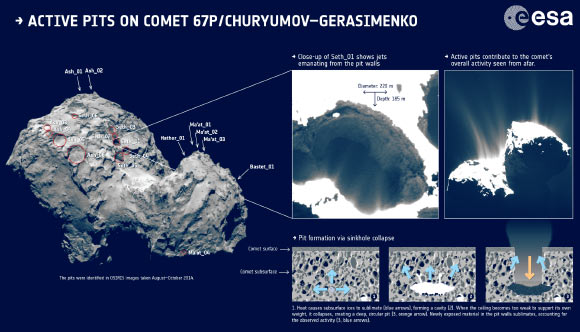In a new study published online in the journal Nature, 18 almost circular pits have been identified in the northern hemisphere of 67P/Churyumov-Gerasimenko. The pits are a few tens to a few hundreds of feet in diameter and extend up to 690 feet (210 meters) below the comet’s surface. These pits are active, and probably created by a sinkhole process, possibly accompanied by outbursts.

Left: 18 pits have been identified in OSIRIS images of the comet’s northern hemisphere; the pits are named after the region they are found in. Middle, top: close-up of the active pit named Seth_01 reveals small jets emanating from the interior walls of the pit. Right, top: context image showing fine structure in the comet’s jets as seen from a distance of 28 km from the comet’s surface on November 22, 2014. Left, bottom: how the pits may form through sinkhole collapse: (1) heat causes subsurface ices to sublimate (blue arrows), forming a cavity (2); when the ceiling becomes too weak to support its own weight, it collapses, creating a deep, circular pit (3, red arrow); newly exposed material in the pit walls sublimates, accounting for the observed activity (3, blue arrows). Image credit: ESA / Rosetta / MPS for OSIRIS Team / UPD / LAM / IAA / SSO / INTA / UPM / DASP / IDA / Jean-Baptiste Vincent et al.
ESA’s Rosetta spacecraft has been monitoring the comet’s activity for over a year, watching how its halo of dust and gas grows as the comet moves closer to the Sun along its orbit.
From a distance of a few hundred miles, the probe observes an intricate pattern of the dust jets emitted from the nucleus as they stream out into space.
But now, thanks to high-resolution images from Rosetta’s Optical, Spectroscopic and Infrared Remote Imaging System (OSIRIS) narrow angle camera from distances of just 6 – 18 miles (10 – 30 km) from the comet center, at least some of these dust jets can be traced back to specific locations on the surface, the first time this has ever been seen.
“These strange, circular pits are just as deep as they are wide. Rosetta can peer right into them,” said study co-author Dr Dennis Bodewits of the University of Maryland.
“We see jets arising from the fractured areas of the walls inside the pits. These fractures mean that volatiles trapped under the surface can be warmed more easily and subsequently escape into space,” added lead author Dr Jean-Baptiste Vincent of the Max Planck Institute for Solar System Research, Germany.
“We propose that they are sinkholes, formed by a surface collapse process very similar to the way sinkholes form here on Earth,” Dr Bodewits said.
Sinkholes occur on our planet when subsurface erosion removes a large amount of material beneath the surface, creating a cavern. Eventually the ceiling of the cavern will collapse under its own weight, leaving a sinkhole behind.
“So we already have a library of information to help us understand how this process works, which allows us to use these pits to study what lies under the comet’s surface,” Dr Bodewits said.
Initially, scientists from the Rosetta mission suspected that discrete, explosive events might be responsible for creating the deep pits.
The probe observed one such outburst during its approach to the comet in April 2014. Catching this event in the act allowed the scientists to quantify how much material had been ejected (between 1,000 kg and 100,000 kg), and it quickly became obvious that the numbers just didn’t stack up. Explosive outbursts alone could not explain the formation of these giant pits.
“The amount of material from the outburst was large – about 100,000 kg – but this is small compared to the size of the comet and could only explain a hole a couple of feet in diameter. The pits we see are much larger. It seems that outbursts aren’t driving the process, but instead are one of the consequences,” Dr Bodewits said.
Based on the Rosetta observations, the scientists have also proposed a model for the formation of these sinkholes.
“We are very interested to see how these active pits evolve and maybe we’ll even witness the formation of a new pit. Being able to observe changes in the comet, in particular linking activity to features on the surface, is a key capability of Rosetta and will help us to understand how the comet’s interior and surface have evolved since its formation,” said Dr Matt Taylor, a scientist for the Rosetta project.
“And with the extension of the mission until September 2016, we can do the best job possible at unraveling how comets work.”
_____
Jean-Baptiste Vincent et al. 2015. Large heterogeneities in comet 67P as revealed by active pits from sinkhole collapse. Nature 523, 63 – 66; doi: 10.1038/nature14564







